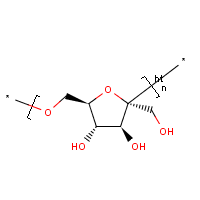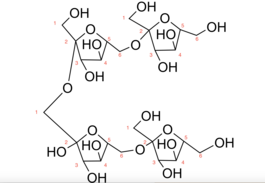
Polysaccharides, or polycarbohydrates, are the most abundant carbohydrates found in food. They are long-chain polymeric carbohydrates composed of monosaccharide units bound together by glycosidic linkages. This carbohydrate can react with water (hydrolysis) using amylase enzymes as catalyst, which produces constituent sugars. They range in structure from linear to highly branched. Examples include storage polysaccharides such as starch, glycogen and galactogen and structural polysaccharides such as cellulose and chitin.
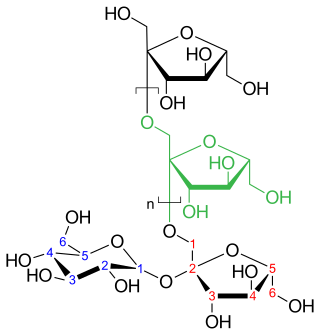
Inulins are a group of naturally occurring polysaccharides produced by many types of plants, industrially most often extracted from chicory. The inulins belong to a class of dietary fibers known as fructans. Inulin is used by some plants as a means of storing energy and is typically found in roots or rhizomes. Most plants that synthesize and store inulin do not store other forms of carbohydrate such as starch. In the United States in 2018, the Food and Drug Administration approved inulin as a dietary fiber ingredient used to improve the nutritional value of manufactured food products. Using inulin to measure kidney function is the "gold standard" for comparison with other means of estimating glomerular filtration rate.
An oligosaccharide is a saccharide polymer containing a small number of monosaccharides. Oligosaccharides can have many functions including cell recognition and cell adhesion.
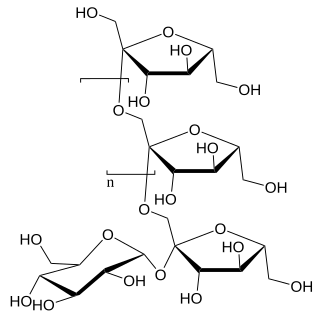
Fructooligosaccharides (FOS) also sometimes called oligofructose or oligofructan, are oligosaccharide fructans, used as an alternative sweetener. FOS exhibits sweetness levels between 30 and 50 percent of sugar in commercially prepared syrups. It occurs naturally, and its commercial use emerged in the 1980s in response to demand for healthier and calorie-reduced foods.
Prebiotics are compounds in food that foster growth or activity of beneficial microorganisms such as bacteria and fungi. The most common environment considered is the gastrointestinal tract, where prebiotics can alter the composition of organisms in the gut microbiome.

Lactobacillales are an order of gram-positive, low-GC, acid-tolerant, generally nonsporulating, nonrespiring, either rod-shaped (bacilli) or spherical (cocci) bacteria that share common metabolic and physiological characteristics. These bacteria, usually found in decomposing plants and milk products, produce lactic acid as the major metabolic end product of carbohydrate fermentation, giving them the common name lactic acid bacteria (LAB).

A fructan is a polymer of fructose molecules. Fructans with a short chain length are known as fructooligosaccharides. Fructans can be found in over 12% of the angiosperms including both monocots and dicots such as agave, artichokes, asparagus, leeks, garlic, onions, yacón, jícama, barley and wheat.

Agave syrup, also known as maguey syrup or agave nectar, is a sweetener commercially produced from several species of agave, including Agave tequilana and Agave salmiana. Blue-agave syrup contains 56% fructose as a sugar providing sweetening properties.

Pantoea is a genus of Gram-negative bacteria of the family Erwiniaceae, recently separated from the genus Enterobacter. This genus includes at least 20 species. Pantoea bacteria are yellow pigmented, ferment lactose, are motile, and form mucoid colonies. Some species show quorum sensing ability that could drive different gene expression, hence controlling certain physiological activities. Levan polysaccharide produced by Pantoea agglomerans ZMR7 was reported to decrease the viability of rhabdomyosarcoma (RD) and breast cancer (MDA) cells compared with untreated cancer cells. In addition, it has high antiparasitic activity against the promastigote of Leishmania tropica.

Curdlan is a water-insoluble linear beta-1,3-glucan, a high-molecular-weight polymer of glucose. Curdlan consists of β-(1,3)-linked glucose residues and forms elastic gels upon heating in aqueous suspension. It was reported to be produced by Alcaligenes faecalis var. myxogenes. Subsequently, the taxonomy of this non-pathogenic curdlan-producing bacterium has been reclassified as Agrobacterium species.
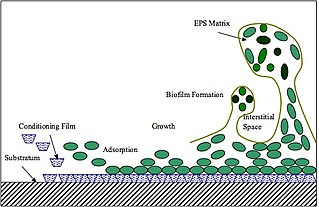
Extracellular polymeric substances (EPSs) are natural polymers of high molecular weight secreted by microorganisms into their environment. EPSs establish the functional and structural integrity of biofilms, and are considered the fundamental component that determines the physicochemical properties of a biofilm. EPS in the matrix of biofilms provides compositional support and protection of microbial communities from the harsh environments. Components of EPS can be of different classes of polysaccharides, lipids, nucleic acids, proteins, lipopolysaccharides, and minerals.
The enzyme levan fructotransferase (DFA-IV-forming) catalyzes the following process:
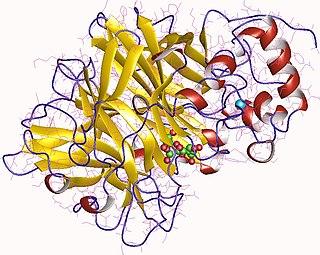
Levansucrase is an enzyme that catalyzes the chemical reaction

Microbiology is the scientific study of microorganisms, those being of unicellular (single-celled), multicellular, or acellular. Microbiology encompasses numerous sub-disciplines including virology, bacteriology, protistology, mycology, immunology, and parasitology.
David Sidney Feingold was an American biochemist.

Glucansucrase is an enzyme in the glycoside hydrolase family GH70 used by lactic acid bacteria to split sucrose and use resulting glucose molecules to build long, sticky biofilm chains. These extracellular homopolysaccharides are called α-glucan polymers.
Chitin-glucan complex (CGC) is a copolymer (polysaccharide) that makes up fungal cell walls, consisting of covalently-bonded chitin and branched 1,3/1,6-ß-D-glucan. CGCs are alkaline-insoluble. Different species of fungi have different structural compositions of chitin and β-glucan making up the CGCs in their cell walls. Soil composition and other environmental factors can also affect the ratio of chitin to β-glucan found in the CGC. Fungal cell walls may also contain chitosan-glucan complexes, which are similar copolymers but have chitosan instead of chitin. Chitin and chitosan are closely related molecules: greater than 40% of the polymer chain of chitin is made of acetylated glucosamine units, whereas greater than 60% of chitosan is made of deacetylated glucosamine units.

Botryosphaeran is an exopolysaccharide (EPS) produced by the ascomyceteous fungus Botryosphaeria rhodina. Characterization of the chemical structure of botryosphaeran showed this EPS to be a (1→3)(1→6)-β-D-glucan. This particular β-glucan can be produced by several strains of Botryosphaeria rhodina that include: MAMB-05, DABAC-P82, and RCYU 30101. Botryosphaeran exhibits interesting rheological properties and novel biological functions including hypoglycaemia, hypocholesterolaemia, anti-atheroslerosis and anti-cancer activity, with potential commercial applications. Three cosmetic products formulated with botryosphaeran have been developed to promote skin health and treat skin conditions for future intended commercialization purposes.

Kestose is a class of sugars that belongs to a group of fructooligosaccharides.
Mutan is a sticky colorless water-insoluble glucan with predominant α-1-3 linkages is the major component of dental biofilms, which enhances the formation of dental plaque and dental caries. It is a source made from glucans which are derived form glucose monomers. Little to nothing is known about the alpha glucans that make up the water-insoluble linkages of mutan with dexteran. These values can be derived using NMR techniques.
